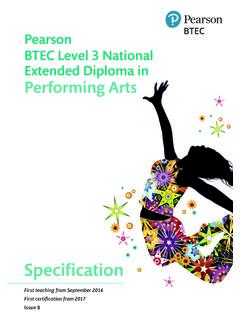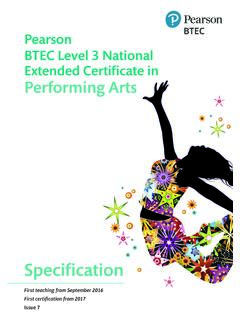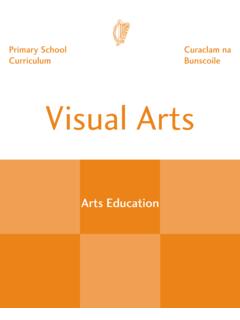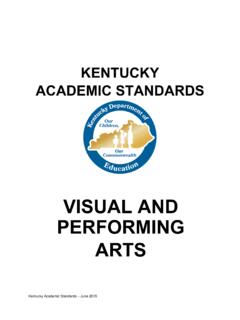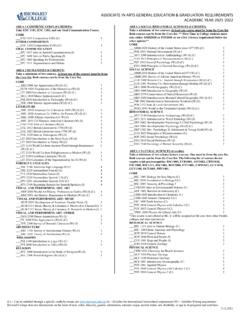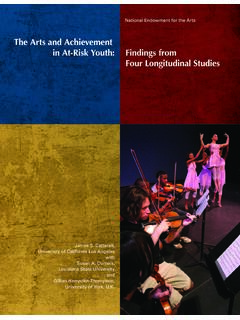Transcription of Elementary Visual Arts Curriculum Guide
1 1 Elementary Visual arts Curriculum Guide Grades K-5 2017-2018 Visual arts include the traditional fine arts such as drawing, painting, printmaking, photography, and sculpture; media arts including film, graphic communications, animation, and emerging technologies; architectural, environmental, and industrial arts such as urban, interior, product, and landscape design; folk arts ; and works of art such as ceramics, fibers, jewelry, works in wood, paper, and other materials. national Art Education Association The Des Moines Public Schools offer a comprehensive, hands-on approach to learning and mastering the skills in Visual arts as a key part of our Educational Philosophy, Vision, Mission, and Student Expectations. Intro to Art 2017-2018 Page 2 Secondary Curriculum Lead Team Editors High School Bryan Butcher, North High School Sam Chiodo, Roosevelt High School Michel Gude, Scavo Alternative High School Samantha Jones-Tweedy, Future Pathways/ Gateway Jason Soliday, East High School Heather Worthington, Lincoln High School Janet Murillo, Hoover High School Superintendent Thomas Ahart, Executive Director of Teaching & Learning Noelle Tichy Visual arts Curriculum Coordinator Benjamin Heinen Elementary Curriculum Lead Team Editors Lisa Hesse, Findley Elementary Kara Dare, Cowles Montessori School Kathryne Marek, Hanawalt Elementary Heather Frank, Brubaker Elementary Kathleen Davenport, Madison Elementary Mindi McCoy, Perkins Elementary David Borzo, Edmunds Elementary Ben Heinen, Oak Park and Cattell Elementary Mirium Alshouse.
2 Gifted and Talented Ashley Wisgerhof, Jackson Elementary Elaine Imlau, Windsor Elementary Secondary Curriculum Lead Team Editors Middle School Derrick Ogden, Brody Middle School Dawn Pinion, Weeks Middle School Virginia Rogers, Hiatt Middle School Diana Givens, McCombs Middle School Intro to Art 2017-2018 Page 3 Foreword Curriculum in this document is based on the national Core arts Standards published in the spring of 2014. It has been developed by Visual art educators and Curriculum specialists in the Des Moines Public Schools. The objectives in this Curriculum Guide are the minimum requirements in the Visual arts that set rigorous, relevant, clear, and measurable learning targets and expectations for what teachers should teach and students should learn. Schools and educators are continuously encouraged to go beyond these targets to better serve the needs of all students in the Visual arts .
3 Definition of the Visual arts Visual arts include the traditional fine arts such as drawing, painting, printmaking, photography, and sculpture; media arts including film, graphic communications, animation, and emerging technologies; architectural, environmental, and industrial arts such as urban, interior, product, and landscape design; folk arts ; and works of art such as ceramics, fibers, jewelry, works in wood, paper, and other materials. national Art Education Association Intro to Art 2017-2018 Page 4 Table of Contents How to use this DMPS Educational DMPS Art Learning Document Learning Topics Standards Referenced Grading K-5 Learning Grade Level Common Elements of Principles of Four-Step Critical Analysis Intro to Art 2017-2018 Page 5 How to use this document: This Curriculum Guide is A lock-step instructional Guide detailing exactly when and how you teach.
4 Meant to restrict your creativity as a teacher. A ceiling of what your students can learn, nor a set of unattainable goals. Instead, the Curriculum Guide is meant to be a common vision for student learning and a set of standards by which to measure and report student progress and provide meaningful feedback. The Curriculum Guide outlines which learning goals are most essential for student learning; it is our district s guaranteed and viable Curriculum . The expectation is that every student in our district, regardless of school or classroom, will know and understand these learning goals. As the classroom teacher, you should use the Curriculum Guide to help you to decide how to scaffold up to the learning goals, and extend your students learning beyond them. The Curriculum Guide is a planning tool; assessed clusters and topics are provided, but as the instructional leader of your classroom, you determine the scope and sequence in which you will introduce the prioritized learning goals.
5 You are encouraged to create your own sub-units of study within each cluster using the topics as a starting point. Within this document you will find a foundational structure for planning instruction in the Visual arts which can be supplemented with unlimited materials from any number of sources, including but not limited to district texts and prints. Please consider this Guide a living and dynamic document, subject to change and a part of a continuous feedback loop. Intro to Art 2017-2018 Page 6 Des Moines Public Schools Educational Philosophy Vision Becoming the model for urban education in the United States. Mission Statement The Des Moines Public Schools Exist So That Graduates Possess the Knowledge, Skills and Abilities to Be Successful at the Next Stage of Their Lives. Student Expectations Students demonstrate proficiency and understanding of a rigorous core Curriculum : They demonstrate proficiency in reading, writing, speaking and listening They demonstrate proficiency in mathematics, including algebra and geometry They demonstrate financial and economic literacy They demonstrate an understanding of the value of fine and performing arts in society They demonstrate proficiency in technological and information literacy They demonstrate proficiency in science, including life, earth and physical science Students possess the knowledge and skills to be self-directed and autonomous.
6 They demonstrate critical thinking and problem solving skills They exercise sound reasoning in making complex choices They exhibit creative, innovative and entrepreneurial thinking They understand the attributes of physical and mental well-being Students have world awareness: They learn from and work with individuals representing diverse cultures and religions in a spirit of mutual respect in school, work and community They understand the rights and obligations of citizenship at local, state, national , and global levels They are actively engaged in community life They will be exposed to languages and cultures of the world Intro to Art 2017-2018 Page 7 o Des Moines Public Schools K-12 Student Learning Objectives in the Visual arts o Students can communicate at a foundational level in the Visual arts . This includes knowledge and skills in the use of basic vocabularies, materials, tools, techniques, and intellectual methods of the discipline.
7 O Students can communicate proficiently in at least one art form, including the ability to define and solve artistic problems with insight, reason, and technical proficiency. o Students can develop foundational evaluations and analyses of works of art from structural, historical, and cultural perspectives. o Students can develop an informed acquaintance with exemplary works of art from a variety of cultures and historical periods, and a basic understanding of historical development in the arts disciplines, across the arts as a whole, and within cultures. o Effective Components of an Educational Studio Program o Demonstrations of artistic techniques and uses of media o Opportunities for practice, experimentation, and refinement based on effective feedback o Support for divergent thinking and multiple learning outcomes o A rich and robust variety of Visual references o A variety of critique and response formats o Introductions to and expectations for use of appropriate art vocabulary o Connections among artists, careers, and art in everyday life and communities o An organizational system for storage and disbursement of materials and tools o Clear and maintained expectations for art room safety, cleaning.
8 And classroom procedures o Integrations and connections with other content areas o Displays of various student works within the school and the community Intro to Art 2017-2018 Page 8 Document Structures Learning goals for all curricular areas are organized by overarching concepts called topics. Within those topics live a learning goal. All learning goals for the Visual arts are guided by the 2014 national Visual arts Standards and assessed on the provided reporting scales. The outline below serves to define the various elements of the Curriculum structure. Learning Topic The Overarching Concept o Definition of the topic. o national Standards alignments those most closely related to the overarching concept. SCALE SCORE ACADEMIC DESCRIPTOR STUDENT-FRIENDLY DESCRIPTOR 4 Exceeding Standard I have demonstrated deep understanding that goes beyond the learning goal 3 Meeting Standard I have met the learning goal 2 Developing Toward Standard I have the foundational skills and knowledge for the learning goal and I am almost there 1 Insufficient Progress The evidence I have submitted shows I have a long way to go to reach the learning goal 0/M No evidence of student understanding in submitted work OR Missing student has not submitted evidence I have not submitted evidence of learning for the learning goal *For more information on district assessment and grading practices.
9 Please refer to the Grading Practices website Intro to Art 2017-2018 Page 9 Standards-Referenced Grading Basics The teacher designs instructional activities that grow and measure a student s skills in the elements identified on our topic scales. Each scale features many such skills and knowledges, also called learning targets. These are noted on the scale below with letters (A, B, C) and occur at levels 2 and 3 of the scale. In the grade book, a specific learning activity could be marked as being 3A, meaning that the task measured the A item at level 3 . When identifying a Topic Score, the teacher looks at all evidence for the topic. The table to the right shows which Topic Score is entered based on what the Body of Evidence shows. Only scores of 4, , 3, , 2, , 1, and 0 can be entered as Topic Scores. Multiple Opportunities It s not about going back to do a retake, or back to redo something; it s about going forward, continually scaffolding student learning through multiple opportunities, and noting that improved learning.
10 Our Curriculum builds on itself. Multiple opportunities are about taking an assessment and connecting it to past topics. It s about allowing students to demonstrate their learning multiple times in units subsequent to their current unit, or when learning is scaffolded into future units. Evidence shows the student Topic Score Demonstrate all learning targets from level 3 and Level 4 Demonstrate all learning targets from level 3 with partial success at Level 4 Demonstrate all learning targets from level 3 Demonstrate some of the level 3 learning targets Demonstrate all learning targets from Level 2 but none of the learning targets from level 3 Demonstrate some of the Level 2 learning targets and none of the level 3 learning targets Demonstrate none of the learning targets from Level 2 or level 3 Produce no evidence appropriate to the learning targets at any level 0 Guiding Practices of Standards-Referenced Grading 1.

